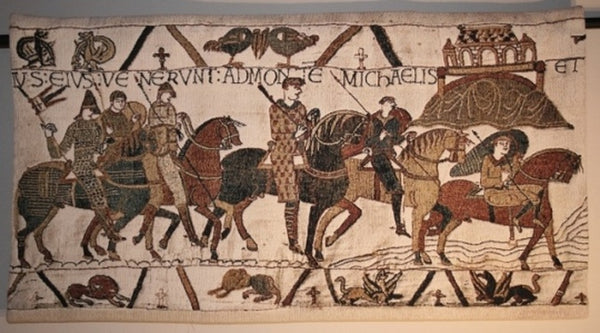
Arms of casual origin include the basic ordinaries of the chief, fesse, chevron, and pale and they probably owe their origin to the bands of metal added to a shield for the sake of increasing its strength. A very early instance is the gold pale (vertical band) on a red shield Gules a pale or, belonging to Hugh de Grandemesnil, in the reign of Henry I, image below. Banded and studded shields appears on the pre-heraldic Bayeux Tapestry. Such shields became heraldic in character when the strengthening pieces were colored differently from the surface (field) of the shield upon which they were laid. The shield of a branch of the Montgomery family provides an example of Arms which sprang from the emblem of an early seal. John Mundegumbri, in the 12th century, had a single fleur-de-lis on his seal, and this developed into three golden fleur-de-lis upon blue Azure three fleur-de-lis or in the shield of his descendents. ( These Arms are identical to the Royal Arms of France but are not connected. Obviously Arms which arose in these haphazard ways can have no primary historic significance, though many of them acquired historical associations through the careers of their bearers.
We saw in the previous post how Coats of Arms of casual origin came about, we next turn to Arms of causal origin or Coats of Arms with a meaning. Foremost in this class of Coats of Arms are those seeking to express the name of the bearer in pictorial form. Frequently men who bore a name capable of heraldic illustration devised Arms that were a pun on the name. This process is known as “canting”, and some prominent early examples of the practice in England include the bull on the Arms of Bovill, the trumpets of Trumpington and the whelk shells on the shield of Shelley. In some instances the pun on the name is not as obvious and some examples of more obscure puns on the name include the fretty design on the shield of Harrington which actually represents a herring net, while the fret design for Maltravers represents something hard to pass.

